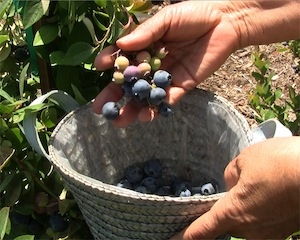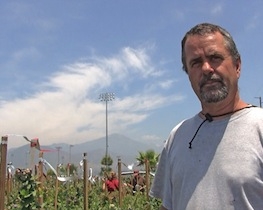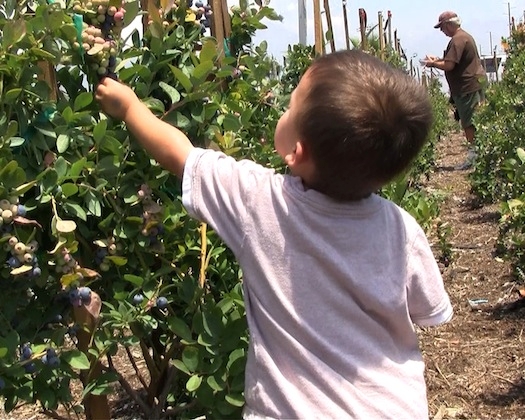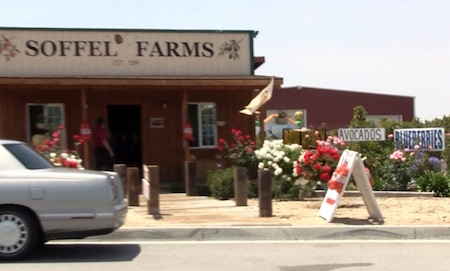Posts Tagged: blueberries
UC aims to improve economic viability of California blueberry farms
California consumers have grown accustomed to enjoying locally grown blueberries in the last decade. Much of the credit goes to UC Cooperative Extension advisor Manuel Jimenez of Tulare County, who has been studying blueberry production and varieties at the UC Kearney Agricultural Research and Extension Center since 1998.
California’s abundant sunshine enables growers to produce high-quality, very sweet Southern Highbush variety blueberries. But, blueberry plants are difficult and expensive to establish and maintain, in part because of California's soil chemistry.
“Blueberries are adapted to grow in forests, in acidic soils,” Jimenez said. “We’re growing them in a desert in alkaline soil. That requires that we acidify the soil when we establish the crop and continuously acidify the irrigation water – which is very costly.”
For example, a 2009 Blueberry Cost Study produced by UC Davis calculated that equipment needs for acidification - including a storage tank, pump and monitoring kit - amounts to $5,500. In addition, the growers must purchase large quantities of sulfuric acid to add to the soil and irrigation water.
Reducing acidification cost is the goal of a new blueberry trial at Kearney, in which Jimenez has grafted the most common commercial blueberry varieties on the roots of farkleberry plants (Vaccinium arboreum). Farkelberry is a small, stiff-branched evergreen bush that is more tolerant of alkaline soils than blueberries.
So far, the two-month-old plants seem to be growing well in their naturally alkaline soil. The coming years will reveal whether using this technique will improve the economic viability of California blueberry farms and provide California consumers with local, healthful and delicious blueberries at a reasonable cost.
The project is being conducted in collaboration with Oregon State University and Florida State University.
Learn more about the blueberry trial by viewing the video below:
Grafting 640 x 360
For foodies, being choosier is getting easier and fun
This season, for Southern California pick-your-own foodies, blueberries are among the latest and fastest growing offerings, thanks to the tenacity of small-scale farmers and the know-how provided by UC Agriculture and Natural Resources experts.
Although U-pick produce operations have been around for many years, farmers who let you hand-pick your blueberries was unheard of in this part of the state until recently.
We may have to thank UC Cooperative Extension farm advisor Manuel Jiménez, who's work on cultivars that he planted in 1997 at the UC Kearney Agricultural Research and Extension Center in Parlier has resulted in about 30 million pounds harvested in about 6,000 acres this year in California, mostly in the San Joaquín Valley.
A few days ago, my wife, Sylvia, and I decided to try our hand at picking our own berries at Soffel Farms in Redlands. It's one of the few local urban farms, or rather farms that became urban in the Inland Empire Area, which is San Bernardino and Riverside counties.
For the second year in a row, Soffel Farms is letting customers harvest as much as they want of its blueberries. This year, Ron Soffel is seeing people who drive more than a hundred miles to do just that.
"They don't see these around here, the closest are when you go up north to the San Joaquín Valley," he said of the blueberries as a new local crop.
By word of mouth, and of quite a few bloggers, locals and not so locals are showing up to pick the micro-nutrient rich blueberries, which many foodies see as magic pills in the fight against some types of cancer and obesity-related diseases like diabetes.
Of course, an incredible flavor helps too. For sure, pickers leave with a better understanding of what it's like to grow and harvest the foods that keep us healthy.
"Once they come up, and experience it, they come back," said Soffel.
Soffel Farms operates very much like other U-pick small-scale farms that are benefiting from agritourism, which UC small farm program has helped to develop to assist local growers. You check in, they give you a little basket and a couple of pointers:
- Walk carefully along the rows of bushes so do not damage the plants.
- Get only the ones that are purple; place the basket under the berries and gently roll your thumb over a berry to make it fall in the basket. (They do, just as if they were waiting for you!)
After you've picked enough, you go back and your berries are packed in 12 oz. plastic containers for which you pay $5 each.
I confess, my wife and I didn't wait until we got home to make sure we had gotten the most delicious blueberries we'd ever tasted! Once you taste a handpicked blueberry, it's hard not to eat some of the ones that should go into the basket.
I felt less guilty after seeing Soffel do the same as we spoke. Other visitors did it too, including a five-year-old who was accompanied by his grandparents, from San Diego. None of his blueberries went to a basket, but straight to his tummy.
"Purple!" he told me every time he put one in his mouth as we went along picking berries. He was the proverbial kid in a candy store. Thank goodness there was lots of that Mother Nature's candy.
As a consumer, I'm thankful that we have our own Manuel Jiménez, who tirelessly proved that blueberries could and should be added to the California cornucopia. And also for the determination of small growers like Soffel in keeping the agriculture tradition alive.
Although many farmers in California are now finding that blueberries are relatively easy to grow, Soffel says it's labor intensive. But it's helping him to keep his family tradition. Like many small-scale farmers, Soffel depends on direct sales. Adding blueberries to his pick-your-own operation, which includes a few acres of orange trees and avocados, is so far proving to be a good source of income, he said.
Soffel is typical of the decreasing number of local growers. They are constantly threatened by urbanization and its accompanying regulations. Soffel is a fifth generation farmer whose ancestors came from Oregon by wagon. The Stoffel Farms sign reads, "Established in 1914." Soffel says his family was among the pioneers that made the Redlands area famous for its oranges.
Most orange groves are gone and have been replaced by housing and commercial buildings; but Soffel and his family refuse to cut their roots to farming.
"I'll be a farmer forever," he told me.
I hope so. I'm waiting for word about his avocados being ready for picking.
(Photos: Alberto Hauffen)
Happiness is . . . California blueberries
Paul Willems, who co-owns Berry Lady Farms in Kingsburg with his wife Gayle, said berry season is a happy time for him and his family. He attributes their sunny disposition to all the blueberries in their diets.
“I feel better when I eat lots of blueberries,” Willems said. “They make you feel happier. I wish I had them all year long.”
Gayle Willems said the fruit may stimulate serotonin in the brain, providing a calming effect. But, she added, the good feelings may not be just the blueberries. "It makes us feel better anytime we eat healthy, right?"
The Willems may also be particularly happy during blueberry season because of the success of their 100-acre farm. The couple grows and sells 12 blueberry varieties over the season at a farm store, farmers markets and through conventional channels. Blueberries are expensive to establish and require a great deal of hand labor for harvest, but they are the second-most valuable crop per harvest acre, after cherries, according to the California Blueberry Association.
The California blueberry industry is growing at a healthy pace, and with 6,000 acres producing about 30 million pounds of the antioxidant-rich fruit, the industry’s volume has now surpassed Florida, said UC Cooperative Extension farm advisor Manuel Jimenez.
The milestone is significant, since the southern highbush blueberry cultivars grown in California originated in the Sunshine State. Southern highbush cultivars are well adapted to the California climate because they require fewer “chill hours” to produce fruit.
A leader in the development of the California industry, Jimenez has conducted blueberry observational trials – looking at yield and flavor characteristics – for more than a decade at the UC Kearney Agricultural Research and Extension Center in Parlier. In addition, the Kearney blueberry plantings have been the scene of ongoing studies on plant spacing, mulches and pruning, research that has helped farmers successfully establish the crop in the semi-arid San Joaquin Valley.
Jimenez will invite blueberry farmers and those considering entering the industry to Kearney this week to taste and compare 35 varieties of berries. Looking over the plots, Jimenez said it wouldn’t be difficult for a farmer to use information from the Kearney trials to select good-tasting berries that ripen sequentially for months, extending one farm's blueberry season from spring until mid-way through the summer.
“You could plant Snow Chaser, a very sweet, early variety, in hoop houses and start harvesting in the second or third week of April,” Jimenez said. “Next, Reveille could come into production. Southmoon is really late and then Centurion, a rabbit eye blueberry that’s small and sweet, would be ready in late July.”
For more information about the blueberry meeting this week at Kearney, see the flyer.
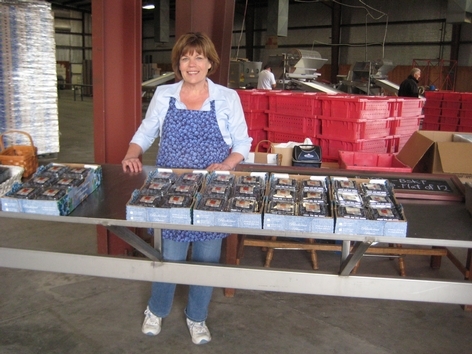
Gayle Willems at the Berry Lady blueberry stand, which sits inside the farm's packing house.
It looks great, but does it taste great?
Taking a look at melons, berries, tomatoes, pears, stone fruit, and more, researchers from UC Davis, along with collaborators from the University of Florida, are focusing on increasing consumption of specialty crops by enhancing quality and safety. Funded by the USDA, work on this Specialty Crops Research Initiative (SCRI) grant began about a year ago.
Americans, after years of hearing that fresh produce is valuable for numerous health benefits, have still not significantly increased their consumption. So, why don’t we eat more fruits and vegetables? Researchers believe that the key reason is that the quality of produce is inconsistent – often with poor texture, flavor or aroma. It might look beautiful on the outside, but when you take a bite – Ugh! It just doesn’t match up to its attractive exterior.
Most produce found at the local market is harvested from the field or orchard before it is fully ripe, shipped a long distance, and then the ripening is completed at a regional produce distribution center or at the local market.
“Harvesting produce early reduces losses due to bruises, decay and other defects,” explained Beth Mitcham, SCRI Grant UCD project leader, “but oftentimes the product never reaches its potential, a full ripe flavor or aroma. Fresh produce, especially when harvested near full ripe stage, can be challenging to handle properly.”
The SCRI grant is an ambitious effort to understand what characteristics are critical for consumers to enjoy produce and develop better methods to measure flavor quality, then work with better tasting varietals and improved shipping and handling practices to allow economically viable delivery of truly delicious fruits and vegetables.
Consumer focus groups are being interviewed for their input, trained taste panels are enjoying a variety fresh produce, and experiments with pallet shrouds and other modified atmosphere transportation experiments are underway. Significant information has already been elicited from consumer groups. Through focus groups, the investigators have discovered that aroma and texture are nearly as important as sweetness, and shoppers get really irritated when produce looks good but tastes bad, and this keeps repeat purchases to a minimum.
Produce managers also have a tough time: set up displays of produce, keep it at the right temperature, watch people wandering around squeezing everything to see if their firmness requirements are met, meanwhile damaging the fruit. It’s a tough market for fresh fruit these days, with fewer consumers’ dollars allocated for produce purchases, but with the advances researchers are making through the SCRI project and others, sweet success is on the way.
Note: This topic was featured on a CBS13 (KOVR) News clip dated 7/17/10, see: http://www.cbs13.com/video/?id=76639@kovr.dayport.com
Bellydancing with your blueberries?
How about looking at Saturn through a telescope, picking your own cherries and blueberries, learning from UC Merced scientists how they estimate snow pack and water flow, taking a dip in the river, tasting local olive oil, wine and cheese, painting a picture, petting a lamb, and camping out in the walnut orchard? About 600 people enjoyed all this and more at the Pick and Gather Festival at Riverdance Farm in Merced County June 5 and 6.
Organic farmers Cindy Lashbrook and Bill Thomson, owners of the 70-acre diversified Riverdance Farm, host this annual event the weekend after Memorial Day. Lashbrook and Thomson are among the growing number of small and mid-scale California farmers and ranchers who open their farm gates to the public for enjoyment and education, helping to build community and connection between the 98 percent of Californians who do not work in agriculture and the 2 percent who do.
The Pick and Gather this year was a mellow family-friendly event with bands, folk-singers and belly-dancers entertaining the crowd. Informational booths, staffed by the UC Cooperative Extension Master Gardeners, the WIC program, Valley Land Alliance, the Merced Farm Bureau and other local groups, were very popular. Local farms offered honey, jams, lemonade, olive oil and other goodies in a shady general store, and there was plenty of room to sit and enjoy lunch prepared by vendors or to eat picnics brought from home. Delicious ripe U-pick organic cherries and blueberries were at wholesale prices. With unemployment in Merced County at about 20 percent this year, Lashbrook and Thomson keep the admission price low and make sure to offer lots of free children’s activities, including art and a petting zoo, and of course, the river to play in.
Riverdance Farm itself, like many farms its size, is having a difficult time staying in business by simply selling crops.The owners would like to see their festival be part of helping sustain the farm financially without losing its friendly community feeling. Most of the visitors were not aware of the costs involved in putting on a festival, from the insurance to the health permit fees to the renting of the water-truck and the porta-potties, not to mention the cost of the farmers’ time away from the work of farming. Lashbrook estimates that it would take another few hundred visitors and maybe some more sponsors and paying vendors to turn the Pick and Gather into an income-generating venture.
The UC Small Farm Program’s agritourism project works to help agritourism operators plan successful and profitable agritourism enterprises on their working farms and ranches, and also to help visitors find festivals and other agritourism activities on working farms and ranches. The Small Farm Program website has a wealth of resources for growers evaluating their own potential for agritourism operations and navigating the risk management, business planning, permitting and promotional aspects of the new businesses.
Agritourism is blossoming in California, with farm tours, classes, farm stays, U-pick operations, farm stands and festivals in almost every county. Potential visitors can find a farm or ranch to visit and check the calendar for events at www.calagtour.org, the University of California’s agritourism directory. Farmers and ranchers are invited to list their agritourism operations and events on the site for no charge.

Riverdance general store

Valley Land Alliance booth

A dip in the Merced River
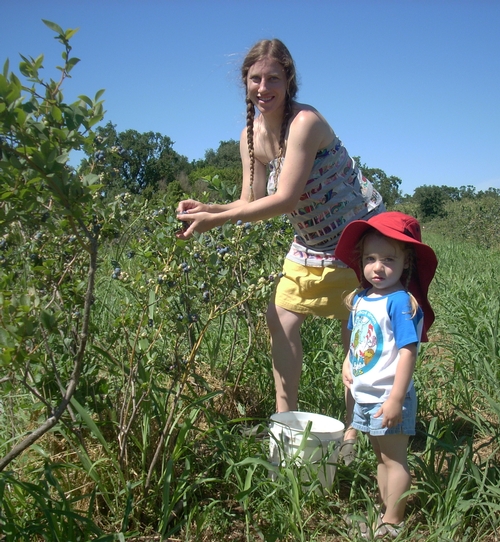
Blueberry pickers



